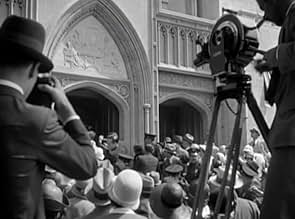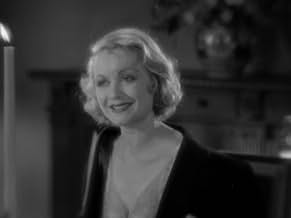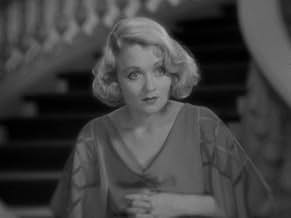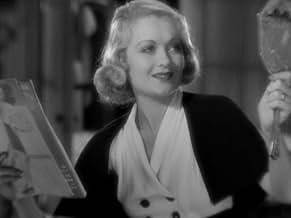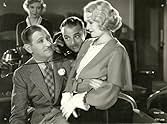IMDb रेटिंग
7.0/10
2.8 हज़ार
आपकी रेटिंग
अपनी भाषा में प्लॉट जोड़ेंThe career of a waitress takes off when she meets an amiable drunken Hollywood director.The career of a waitress takes off when she meets an amiable drunken Hollywood director.The career of a waitress takes off when she meets an amiable drunken Hollywood director.
- 1 ऑस्कर के लिए नामांकित
- 3 जीत और कुल 1 नामांकन
George Reed
- Undetermined Secondary Role
- (काटे गए सीन)
Alice Adair
- Undetermined Secondary Role
- (बिना क्रेडिट के)
Eddie 'Rochester' Anderson
- James - Max's Butler
- (बिना क्रेडिट के)
Sam Armstrong
- Undetermined Secondary Role
- (बिना क्रेडिट के)
Zeena Baer
- Secretary to Julius Saxe
- (बिना क्रेडिट के)
King Baggot
- Department Head
- (बिना क्रेडिट के)
Gerald Barry
- John Reed - an Actor
- (बिना क्रेडिट के)
Floyd Bell
- Undetermined Secondary Role
- (बिना क्रेडिट के)
Veda Buckland
- Nana - Jackie's Nursemaid
- (बिना क्रेडिट के)
Nicholas Caruso
- Chef at Brown Derby
- (बिना क्रेडिट के)
Lita Chevret
- Actress Filming on Movie Set
- (बिना क्रेडिट के)
फ़ीचर्ड समीक्षाएं
Alcoholic director Max Carey (Lowell Sherman) discovers waitress Mary Evans (Constance Bennett). She becomes a big star and marries handsome Lonny Borden (Neil Hamilton)...but Carey's alcoholism starts to kill him and Lonny can't deal with his wife's stardom....
Very predictable but good. This movie moves VERY quickly; is well-directed by George Cukor; has some sharp pre-Code dialogue and has a good script that gives an interesting look at Hollywood in the 1930s. The church sequence especially is fascinating. It gets a little overly silly at the end but it still works.
Bennett is just great--beautiful and believable; Sherman was good also; Hamilton is just so-so but he's unbelievably handsome so that helps. Gregory Ratoff also gets some laughs as a VERY excitable studio head.
This was (pretty obviously) the inspiration for the later "A Star Is Born" movies but stands on its own merit. I give it an 8.
Very predictable but good. This movie moves VERY quickly; is well-directed by George Cukor; has some sharp pre-Code dialogue and has a good script that gives an interesting look at Hollywood in the 1930s. The church sequence especially is fascinating. It gets a little overly silly at the end but it still works.
Bennett is just great--beautiful and believable; Sherman was good also; Hamilton is just so-so but he's unbelievably handsome so that helps. Gregory Ratoff also gets some laughs as a VERY excitable studio head.
This was (pretty obviously) the inspiration for the later "A Star Is Born" movies but stands on its own merit. I give it an 8.
The direction of George Cukor for this film is excellent. The three lead characters have three charming, yet completely different personalities. The great talent of George Cukor doesn't allow the energy of any of his characters to wane. The performance of Lowell Sherman only adds to the wonderful script, and only the innocence of Constance Bennett is able to carry the role of an aspiring starlet that makes it so believable. Neil Hamilton (later to play the 'Commissioner' on the "Batman" TV series of the mid-1960's) is excellent as the 'love interest'. But it is Lowell Sherman who steals nearly every scene in the wonderful jewel of a film. The story of this film is like many real-life stories of almost everyone who has ever worked in Hollywood - either in front of the camera or behind the lens. To me, this IS the original "A Star is Born", and that is why it is one of my favorite films of all time. From the appearance of Eddie "Rochester" Anderson to the Brown Derby to the scenes of the night life of the early days of Hollywood, "What Price Hollywood?" will always be a memorable film for me.
It's fun to compare "What Price Hollywood," made in 1932, to the more familiar 1937 version of "A Star is Born" (as well as its two later remakes). An important historic event intervened between the two: the Hays Code became rigidly enforced in 1934. The 1932 version is much spicier. Mary, the unknown knockout in in the 1932 version, is a saucy waitress at the legendary Brown Derby restaurant trying to catch the eye of a movie big shot. She's pretty sophisticated and, you believe, would happily do whatever is required to land an acting job. She readily allows herself to be picked up and taken to a premiere by a famous (but fading) director, which launches her great career. In the 1937 version, Esther, the ingenue, is straight off the farm and comes to Hollywood without a clue about the movie biz. She's a goody-two-shoes who would be shocked about what it usually takes to break into the biz. She catches the eye of a famous (but fading and highly alcoholic) actor when she waitresses at a party.
There is one major plot difference: in the 1932 version, Mary marries a rich polo playing socialite who divorces her (while she's pregnant) because he is fed up with movie people. This is highly realistic--movie stars had terrible marital problems. In the 1937 version, Esther marries the actor who was her mentor and is sucked into his hopeless downward spiral. Divorce is a perfectly acceptable solution to marital problems in 1932 but, under the constraints of the Code, was out of the question in 1937.
Both films are well worth seeing. They're loaded with insights about Hollywood and filmmaking (both the creative and the business end), the rapacious movie press, and the fans--an insatiable monster that devours the object of its affection. The declining fortunes of the director (in "What Price Hollywood") and the actor (in "A Star is Born") are quite fascinating. But of the two--the 1932 version is a lot more fun.
There is one major plot difference: in the 1932 version, Mary marries a rich polo playing socialite who divorces her (while she's pregnant) because he is fed up with movie people. This is highly realistic--movie stars had terrible marital problems. In the 1937 version, Esther marries the actor who was her mentor and is sucked into his hopeless downward spiral. Divorce is a perfectly acceptable solution to marital problems in 1932 but, under the constraints of the Code, was out of the question in 1937.
Both films are well worth seeing. They're loaded with insights about Hollywood and filmmaking (both the creative and the business end), the rapacious movie press, and the fans--an insatiable monster that devours the object of its affection. The declining fortunes of the director (in "What Price Hollywood") and the actor (in "A Star is Born") are quite fascinating. But of the two--the 1932 version is a lot more fun.
This early effort by director George Cukor had such resonance that it was remade three times as A STAR IS BORN, so it lives on to satisfy the curiosity of those who admire one or more of the later productions. What holds it up after all these years are a strong and realistic performance by Lowell Sherman as a successful Hollywood film director whose alcoholism is destroying his career, decent and sometimes brilliant work by ever-stylish Constance Bennett as the ambitious waitress who becomes an overnight star, beautiful and poetic montages by Slavko Vorkapich, a generally witty and clever script by a team of about eight writers including Adela Rogers St. John and Gene Fowler, and some beautifully directed intimate scenes including the opening in which Bennett dresses for work, copying the beauty tips advertised in the fan magazine she is reading. Highlights: the screen test in which Bennett repeatedly fails to gracefully descend a staircase, deliver one line and then react to the sight of a dead body outside camera range; the filming of a nightclub scene in which Bennett delivers a love song in French (a la Dietrich in MOROCCO) as she strolls among the seated patrons. When you think about it, Bennett is really too sophisticated and worldly for this part, which is why it worked much better for the homespun Janet Gaynor five years later. It really doesn't make sense that a lady who can handle herself with complete ease after being dragged to a movie premiere and unexpectedly shoved in front of a microphone would suddenly turn into a klutz in front of a movie camera in a studio screen test. At one point Bennett is seen to converse in flawless, fluent French and we can only wonder how a lowly waitress with naïve dreams of movie stardom ever got that kind of linguistic education. The only explanation could be that the casting of Bennett required compromises. In any case, her natural charm carries her through.
At times the story drags. Neil Hamilton as the stuffed shirt husband adds to the dead weight. The sound quality in the outdoor scenes is weak and tinny. Gregory Ratoff as a studio chieftain has fun but his accent is a bit too thick given the limitations of the recording techniques of the time. Louise Beavers, as always, enlivens her small role as Bennett's maid.
At times the story drags. Neil Hamilton as the stuffed shirt husband adds to the dead weight. The sound quality in the outdoor scenes is weak and tinny. Gregory Ratoff as a studio chieftain has fun but his accent is a bit too thick given the limitations of the recording techniques of the time. Louise Beavers, as always, enlivens her small role as Bennett's maid.
"What Price Hollywood?" is one of my favorite films of the 1930s. With loads of drama, glamour to spare, and some romance too, this movie is one of the best behind-the-scenes looks at the old Hollywood studio system that was ever made. Constance Bennett, looking her radiant best, plays the lead role with finesse. Lowell Sherman also turns in a powerful performance as a washed-up director. This movie was the basis for "A Star is Born." All in all, one great film.
क्या आपको पता है
- ट्रिवियाThis film bears such a striking resemblance to A Star Is Born (1937) that it is often considered "the original version" of that often remade classic. In fact, David O. Selznick, who produced both this film and Star is Born, was threatened with a lawsuit by this film's writers, claiming plagiarism.
- गूफ़When the screen shows a newspaper gossip column, part of an item relating a joke about a Jewish boy and a bird can be seen. Several months later, another gossip column shows the identical item.
- क्रेज़ी क्रेडिटThere is a "by" credit to Gene Fowler and Rowland Brown after the title shows, but there is also a "screenplay by" credit to Jane Murfin and Ben Markson, without leaving any clear explanation or context as to what "by" actually means. But the reality was that Fowler and Brown wrote the real screenplay, with Murfin and Markson providing the continuity.
- कनेक्शनFeatured in David O. Selznick: 'Your New Producer' (1935)
- साउंडट्रैकThree Little Words
(1930) (uncredited)
Music by Harry Ruby
Part of a medley played during the opening credits
टॉप पसंद
रेटिंग देने के लिए साइन-इन करें और वैयक्तिकृत सुझावों के लिए वॉचलिस्ट करें
- How long is What Price Hollywood??Alexa द्वारा संचालित
विवरण
- रिलीज़ की तारीख़
- कंट्री ऑफ़ ओरिजिन
- भाषाएं
- इस रूप में भी जाना जाता है
- Hollywood Madness
- फ़िल्माने की जगहें
- उत्पादन कंपनी
- IMDbPro पर और कंपनी क्रेडिट देखें
बॉक्स ऑफ़िस
- बजट
- $4,11,676(अनुमानित)
- चलने की अवधि1 घंटा 28 मिनट
- रंग
- पक्ष अनुपात
- 1.37 : 1
इस पेज में योगदान दें
किसी बदलाव का सुझाव दें या अनुपलब्ध कॉन्टेंट जोड़ें


